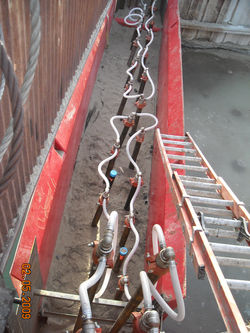Utilities and Pump Stations
We are specialists in providing cost-effective, minimally invasive, impermeable shoring for the installation of lift stations and other underground structures. Freezing is superior to conventional shoring for eliminating lateral groundwater movement into the excavation. Our versatile system can be shaped, as necessary, can incorporate existing utilities so that rerouting is not necessary, and can work around underground obstructions. When

dewatering is limited or costly due to quantity to local regulations, soil contaminate treatment, or possible existing structure damage from settlement, the SoilFreeze system is a solution.
Design considerations: Existing utilities or known obstructions are addressed in the design phase by locating vertical freeze pipes on either side of the utility or obstruction or by using angled pipes to close the shoring wall below. As in all other applications where a “dry hole” is desired, the design engineer analyzes all strata below the groundwater table to determine the depth required for the unfrozen “plug.” Specialized engineering and construction experiences are critical to provide the most cost-effective, successful solution. Freeze pipes installed too deep will add unnecessary costs to your project, too shallow will cause unnecessary dewatering.
Case Examples:
Lake Tahoe Pump Station
The Project
The Tahoe City Public Utility Department required a new pump station 50 feet from Lake Tahoe as part of a water distribution system. The pump station’s dimensions were planned to be 28 feet by 12 feet and 24 feet in depth. Previous attempts to excavate the ground using conventional shoring techniques while keeping within the restrictive dewatering requirements were unsuccessful.
The Results
The combined strength of our conventional freeze pipes, creating a frozen soil perimeter wall, and our zone freeze pipes, creating a bottom frozen soil plug, successfully retained the soil and groundwater around the excavation perimeter and prevented upward flow of groundwater through the excavation base. The general contractor was able to complete the pump station construction without dewatering.
The Challenge
Soil conditions at the site were highly variable, consisting of sand and gravel over clay seams, and large rock fragments. These conditions and rock fragments would inhibit any type of shoring installation. The proximity to the lake combined with the highly permeable soil layers led to very high dewatering pumping rates; beyond those allowed by the Lake Tahoe water conservation district.
The Solution
SoilFreeze was contracted to design and construct a continuous structural frozen soil wall around the site to retain soil and groundwater. To prevent groundwater inflow from below the excavation, we installed a series of patented zone freeze pipes in the middle of the site to create an impermeable frozen soil barrier below the excavation base.
 |  |  |
|---|---|---|
 |  |  |
 |  |  |
 |  |
L-Structure Water Inlet
The Project
The L-Structure is an inlet area retained on three sides by steel sheet piles that were driven into an underlying claystone layer 26 feet deep. City water is pumped from the inlet area through a series of steel pipes that run up into a small treatment building. The city needed to install new, larger diameter inlet pipes at a deeper elevation.
The Challenge
The soil conditions consisted of silty, gravelly sand with cobbles over claystone. The existing steel sheet pile wall was embedded only to the top of the claystone and would be undermined with the planned excavation. This project also required a temporary cofferdam to protect the excavation from the Yellowstone River.
The Solution
SoilFreeze installed a series of 3-inch diameter steel freeze pipes to 40-feet around the planned excavation area. The freezing extended well into the claystone and directly against the existing building foundation to cutoff groundwater. SoilFreeze also created a frozen soil cofferdam inside stacked trench boxes to keep the river out of the excavation.
 |  |  |
|---|---|---|
 |  |  |
 |  |  |
The Results
The frozen soil wall was water tight and stable around the entire excavation. The frozen soil cofferdam along the river worked as planned, allowing the work inside the excavation to be completed dry.


